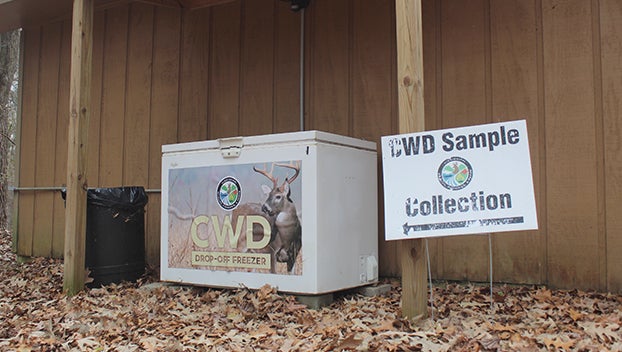New Chronic Wasting Disease detection should be a wake up call for low sampled counties
Published 12:16 pm Friday, December 1, 2023

- Chronic Wasting Disease samples must be submitted if you harvest a buck during velvet season. Sample coolers look like this one pictured here at Natchez State Park. (Hunter Cloud | The Natchez Democrat)
JACKSON — Mississippi Department of Wildlife, Fisheries and Parks confirmed a deer tested positive for Chronic Wasting Disease in Harrison County. The new positive is 153 miles away from the nearest CWD positive in Tensas Parish, Louisiana and should be a wake up call for other low sampled counties.
Chronic Wasting Disease is a 100 percent always fatal disease in deer and other members of the cervidae families caused by infectious prions. Mississippi has 221 CWD positives and more will likely be entered on the CWD dashboard today.
Assistant Deer Program Coordinator Kamen Campbell said the positive was detected two weeks ago and confirmed by a national diagnostic laboratory Wednesday. The positive is 160 miles away from the nearest positive in Warren County and 215 miles away from the first nearest positive detection in Florida. In other words, it is unlikely this new detection is connected to other outbreaks.
Under MDWFP’s current CWD Management plan, parts of Harrison and Hancock County would likely be placed into CWD Control Zones which bans supplemental feeding and carcass transportation. It is likely to come up at the next MDWFP commission meeting on December 14 in Jackson.
“Right now there are three or four options of how it could have gotten there but we aren’t sure how. It is a historically under sampled area and we suspected there was a chance it could be there,” Campbell said. “It is hard to find anything in that small of sample size. Some of the hunters there do travel north to hunt and might have unknowingly brought CWD back before the carcass transportation bans. Hopefully six months from now we will know how it got there but we still don’t know where the Issaquena County positive got there in 2018. We are still trying to piece together the puzzle.”
Hancock County submitted 127 samples for CWD testing since first detection in 2018 and Harrison County submitted 86 samples.
Statewide Hunters have been busy submitting samples this year. Deer Program Coordinator William McKinley said he expected positive results to continue to be detected Thursday morning. Mississippi State University Veterinary Diagnostic Laboratory in Pearl has been churning through samples each day. The number of samples is reflected in the Chronic Wasting Disease Dashboard which is updated nearly every day and sometimes multiple times throughout the day.
Campbell said he talks to hunters all the time in Franklin, Lincoln and Adams Counties about Chronic Wasting Disease. Hunters there who are not concerned about the disease should be. Lincoln County has submitted 421 samples since 2018, Franklin County has submitted 361 samples for testing and Adams County has submitted 425 samples.
“They aren’t concerned and don’t have their deer tested. I wouldn’t eat a deer from anywhere in the state that hasn’t been tested. Never sure where it could pop up. It could have been there for 10 years and we didn’t know it,” Campbell said. “Hancock County is a perfect example. Everyone should be testing their deer because we are not sure where we will find it next. If we want to find the disease at a 5 percent prevalence rate we need 300 samples per year and no county is anywhere close to that down there. At a 5 percent prevalence rate it already has a foot hold, our goal is to find it at 1 percent. What we can do as a state is increase sampling.”
Answers about CWD
Chronic Wasting Disease prions are shed into the environment in the bodily fluids of infected deer. Healthy deer can become infected by indirect contact with these prions in the soil or direct contact with an infected deer. Prions persist in the environment for a long period of time long after a CWD infected deer dies.
Deer do not show symptoms of CWD until the later stages of the disease which could be 12 to 18 months after they become infected which is why it is important for deer to be tested. The Center for Disease Control reports there are no CWD cases in humans from eating positive deer meat but it doesn’t mean the disease can’t spread to humans. It is best to avoid eating meat of a CWD positive deer.
CWD samples can be dropped off at self serve coolers around the state or participating taxidermists. The closest drop-off cooler to Lincoln County is in Hazlehurst at the Mississippi State Extension Service Office there. Lincoln County’s participating taxidermists are Brent Opdyke, Allen Morgan and George Wilson and their information can be found on the MDWFP CWD page.





